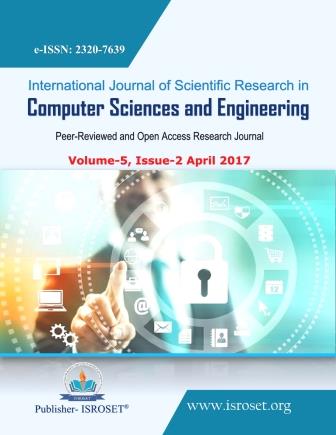REVIN: Reduced Energy Virtuous Immune Network for WSN
Keywords:
Sink Node, Security, Localization, Clustering, nergy Constrained, WSNAbstract
Sink node’s location privacy is one of the critical issues in wireless sensor network (WSN), as sink node is the central point of sensed data collection and act as gateway between wireless network and wired infrastructure. An attacker can attack on sink node to capture whole network due to shared nature of wireless channel. In existing work, large energy consumption is there in providing security to sink node. So there is a trade-off between energy consumption and security in WSN. To address these issues, we have proposed an algorithm in this paper, named REVIN (Reduced Energy Virtuous Immune Network). In proposed algorithm, a small fraction of advanced nodes are used to prolong the network lifetime. Sleep scheduling mechanism is implemented in static fixed clusters. Region based clustering is done by sink node. To provide privacy of sink node lo cation, at least 15 other nodes in the WSN have similar traffic statistics as the sink node. Simulation results show that our proposed algorithm perform better in terms of energy consuption and provide better sink node privacy.
References
C. M. George, T. Jacob, “Privacy Towards Base Station In Wireless Sensor Networks Against a Global Eavesdropper – A Survey”, International Journal of Computer Science and Management Research, Vol.2, Issue.4, pp. 1493-1497, 2013.
M. Holiday, S. Venkatesan, N. Mittal, “Secure Location Verification with Randomly-Selected Base Stations”, 31st International Conference on Distributed Computing Systems Workshops, USA, pp. 119-122, 2011
M. Younis, Z. Ren, “Effect of Mobility and Count of Base-stations on the Anonymity of Wireless Sensor Networks”, 7th International Wireless Communications and Mobile Computing Conference, USA, pp. 436-441, 2011.
M. Conti, B. Crispo, and J. Willemsen, “Providing Source Location Privacy in Wireless Sensor Networks: A Survey”, IEEE Communications Surveys & Tutorials, pp.410-419 2013.
Niharika Singh Matharu and Avtar Singh Buttar, “An Efficient Approach for Localization using Trilateration Algorithm based on Received Signal Strength in Wireless Sensor Network”, International Journal of Computer Sciences and Engineering, Vol.3, Issue.8, pp.11-16, 2015.
S.S. Kumar, A.G. Selvarani, “Improving Energy Efficiency by Using Tree-Based Routing Protocol for Wireless Sensor Network”, International Journal of Computer Sciences and Engineering, Vol.3, Issue.3, pp.201-206, 2015.
E. Ngai, “On providing sink anonymity for sensor networks”, in Proceedings of 2009 International Conference on Wireless Communications and Mobile Computing: Connecting the World Wirelessly. ACM, pp. 269–273, 2009.
S. Tyagi, J. Kaur, “A Literature Review in Wireless Sensor Hole Detection Along with Node Scheduling Algorithm”, International Journal of Computer Sciences and Engineering, Vol.4, Issue.8, pp.28-32, 2016.
Y. Jian, L. Zhang , S. Chen, Z. Zhang, “A novel scheme for protecting receiver’s location privacy in wireless sensor networks,” Wireless Communications, IEEE Transactions, Vol.7, Issue.10, pp. 3769–3779, 2008.
K. Mehta, M. Wright, D. Liu, “Location privacy in sensor networks against a global eavesdropper,” IEEE International Conference on. IEEE, pp. 314–323, 2007.
A. F. Callanan, P. Thulasiraman,” Achieving Sink Node Anonymity Under Energy Constraints in Tactical Wireless Sensor Networks”, IEEE International Multi-Disciplinary Conference on Cognitive Methods in Situation Awareness and Decision, Orlando, pp-186-191, 2015
Y. Ebrahimi and M. Younis, “Using deceptive packets to increase base station anonymity in wireless sensor network”, 7th International Wireless Communications and Mobile Computing Conference, Istanbul, pp.842–847, 2016
G. Anastasi, M. Conti, M. Di Francesco, A. Passarella, “Energy conservation in wireless sensor networks: A survey”, Ad Hoc Networks, Vol.7, Issue. 3, pp. 537–568, May 2009.
Aditya Singh Mandloi and Vinita Choudhary, “An Efficient Clustering Technique for Deterministically Deployed Wireless Sensor Networks”, International Journal of Scientific Research in Network Security and Communication, Vol.1, Issue.1, Page No (6-10), Mar -Apr 2013
C. Intanagonwiwat, R. Govindan, D. Estrin, “Directed diffusion: A scalable and robust communication paradigm for sensor networks”, ACM International Conference on Mobile Computing and Networking, USA, pp. 56–67, 2000
J. Kulik, W. Heinzelman, H. Balakrishnan, “Negotiation-based protocols for disseminating information in wireless sensor networks”, Wireless Networks, Vol. 8, Issue.2, pp. 169–185, 2002.
R. Kachal, S. Suri, “Comparative Study and Analysis of DSR, DSDVAND ZRP in Mobile Ad-Hoc Networks”, International Journal of Computer Sciences and Engineering, Vol.2, Issue.5, pp.148-152, 2014.
Uma Korupolu, S Kartik and G Kalyan Chakravarthi, “An Efficient Approach for Secure Data Aggregation Method in Wireless Sensor Networks with the impact of Collusion Attacks”, International Journal of Scientific Research in Computer Science and Engineering, Vol.4, Issue.3, pp.25-28, 2016.
R. Nathiya, S.G. Santhi, “Energy Efficient Routing with Mobile Collector in Wireless Sensor Networks (WSNs)”, International Journal of Computer Sciences and Engineering, Vol.2, Issue.2, pp.36-43, 2014.
Downloads
Published
How to Cite
Issue
Section
License

This work is licensed under a Creative Commons Attribution 4.0 International License.
Authors contributing to this journal agree to publish their articles under the Creative Commons Attribution 4.0 International License, allowing third parties to share their work (copy, distribute, transmit) and to adapt it, under the condition that the authors are given credit and that in the event of reuse or distribution, the terms of this license are made clear.







